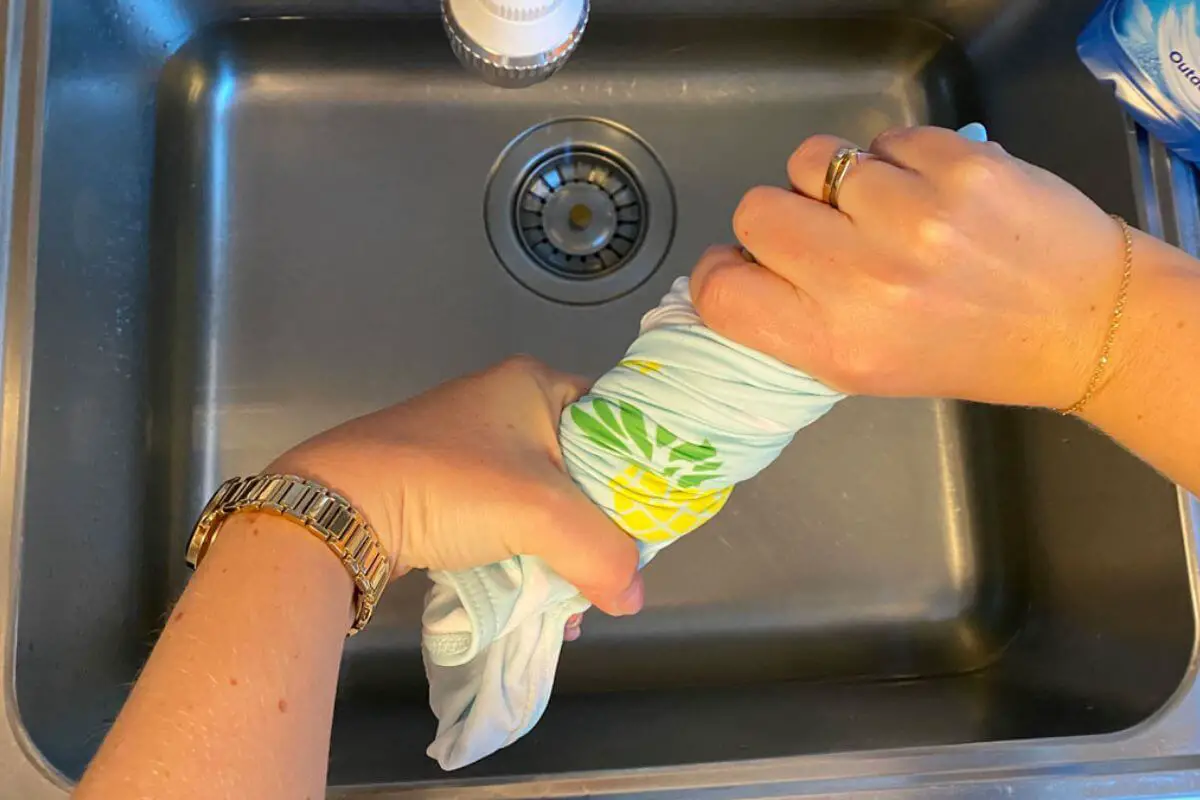When it comes to our cherished bathing suits, the last thing we want to discover is the unwelcome presence of mold. Mold not only tarnishes the appearance of our swimwear but can also pose potential health concerns. In this comprehensive guide, we’ll delve into what mold on a bathing suit looks like, how it forms, and crucial tips on prevention and remediation.
Decoding Mold on Bathing Suits: Recognizing the Signs
Discovering mold on your cherished bathing suit can be disheartening, but recognizing the signs early is crucial for effective remediation. Let’s decode the subtle indicators that reveal the presence of mold on your swimwear.

1. Fuzzy or Discolored Patches:
- Appearance: Mold often manifests as fuzzy or discolored patches on the fabric of your bathing suit. These patches can take on various colors, such as black, green, brown, or white, signaling the growth of mold spores.
2. Musty Odor:
- Smell: Mold comes with a distinct musty odor. If you detect an unpleasant smell emanating from your bathing suit, it’s a clear indication that mold may be present. The musty odor is a result of the metabolic processes of mold spores.
3. Texture Changes:
- Feel: The texture of the fabric can change when mold is present. If your once-smooth bathing suit now feels rough or uneven in certain areas, it’s a sign that mold has taken hold. The growth of mold colonies can alter the surface texture of the fabric.
4. Stains That Resist Cleaning:
- Staining: Mold stains can be stubborn and resist regular cleaning efforts. If you’ve attempted to remove stains without success, it may be an indication that mold has penetrated the fabric. These persistent stains often reveal the presence of mold.
Understanding these signs empowers you to take proactive measures against mold growth on your bathing suits. Early detection allows for swift remediation, preserving the longevity and vibrancy of your swimwear.
How Does Mold Form on Bathing Suits?
**1. Moisture and Humidity:
- Ideal Conditions:* Mold thrives in damp and humid environments. Wet bathing suits, if not properly dried, create a perfect breeding ground for mold spores.
**2. Improper Storage:
- Ventilation Matters:* Storing bathing suits in a confined space without proper ventilation can contribute to mold growth. Ensure your swimwear is stored in a well-ventilated area.
**3. Extended Dampness:
- Prompt Drying:* Leaving wet bathing suits in a bag or piled up for an extended period increases the likelihood of mold formation. Promptly dry your swimwear after use to prevent mold development.
**4. Inadequate Cleaning:
- Thorough Washing:* Inadequate cleaning after each use can leave behind residues that mold spores feed on. Ensure your bathing suits are thoroughly washed and rinsed.
Preventing Mold: Best Practices for Bathing Suit Care
Preserving the beauty and longevity of your bathing suits involves more than just enjoying them under the sun. Implementing proper care practices is essential to prevent the unwelcome guest—mold. Here are the best practices for bathing suit care that will keep mold at bay.
1. Proper Drying:
- Air Dry: After each use, make sure to air-dry your bathing suit thoroughly. Avoid folding or piling damp suits, as this can create an environment conducive to mold growth. Hang your swimwear in a well-ventilated area to allow for optimal drying.
2. Sunlight Exposure:
- Natural Disinfectant: Harness the natural disinfectant properties of sunlight. After washing, allow your bathing suit to bask in the sunlight for a brief period. Sunlight not only helps to dry the fabric but also inhibits the growth of mold.
3. Ventilated Storage:
- Breathability: When not in use, store your bathing suits in a well-ventilated area. Avoid sealing them in plastic bags or containers without proper airflow. Breathable storage allows air circulation, minimizing the risk of mold formation.
4. Regular Cleaning:
- Gentle Wash: After each use, clean your bathing suits with a mild detergent. Rinse them thoroughly to remove any salt, chlorine, or sand residues that can serve as a breeding ground for mold. A gentle hand wash is often preferable to preserve the fabric.
5. Rotate Swimwear:
- Prevent Overuse: Give each bathing suit ample time to dry completely by rotating your swimwear. Avoid wearing the same suit consecutively to ensure they all get enough time to air out and remain mold-free.
By incorporating these preventive measures into your bathing suit care routine, you not only maintain their pristine condition but also guard against the potential invasion of mold. Taking proactive steps ensures that your swimwear is always ready for the next aquatic adventure.
Remediation: Tackling Mold on Bathing Suits
**1. White Vinegar Soak:
- Natural Solution:* Soak the affected bathing suit in a solution of white vinegar and water. Vinegar’s natural antifungal properties can help eliminate mold.
**2. Baking Soda Paste:
- Gentle Scrub:* Create a paste using baking soda and water. Gently scrub the mold-affected areas with this paste, then rinse thoroughly.
**3. Anti-Mold Laundry Detergent:
- Specialized Products:* Consider using anti-mold laundry detergents designed to eliminate mold and mildew from fabrics.
**4. Professional Cleaning:
- Consulting Experts:* For persistent mold issues, seek professional cleaning services to ensure effective removal without damaging the fabric.
In Conclusion: Preserving Your Swimwear, Warding off Mold
As we conclude this guide on bathing suit care, it’s evident that preserving your swimwear goes beyond aesthetics; it’s about ensuring a mold-free and enjoyable experience each time you take a dip. By adhering to proper care practices, you not only maintain the vibrancy of your bathing suits but also safeguard against the potential intrusion of mold.
In summary, here are key takeaways to keep in mind:
1. Regular Maintenance:
- Thorough Cleaning: Clean your bathing suits after each use, removing any residues that can contribute to mold growth. A gentle hand wash and proper rinsing are effective preventive measures.
2. Adequate Drying:
- Air Dry: Allow your swimwear to air-dry completely before storing it. Proper drying prevents the accumulation of moisture, reducing the risk of mold formation.
3. Sunlight Exposure:
- Natural Defense: Take advantage of sunlight exposure to disinfect and inhibit mold growth. A brief sunbath after washing adds an extra layer of protection.
4. Rotation and Storage:
- Rotate Swimwear: Avoid overusing the same bathing suit consecutively. Rotate your swimwear to ensure each piece gets sufficient time to dry thoroughly.
5. Vigilance for Signs:
- Early Detection: Be vigilant for signs of mold, such as discoloration, musty odor, and texture changes. Early detection allows for prompt remediation.
By incorporating these practices into your bathing suit care routine, you not only extend the life of your swimwear but also create a hygienic and pleasant experience each time you wear them. So, dive into your next water adventure with confidence, knowing that your swimwear is well-preserved and mold-free.
Remember, proper care is the key to a lasting and enjoyable relationship with your bathing suits.
Let’s embrace swimsuit seasons with confidence, knowing our swimwear is mold-free and ready for the next splash.
FAQs: Navigating the Waters of Mold on Bathing Suits
1. Can mold on a bathing suit be harmful to health?
- Answer: While mold on a bathing suit is generally more of a nuisance than a health threat, prolonged exposure to mold can cause respiratory issues and skin irritation. It’s essential to address mold promptly to minimize any potential health risks.
2. How often should I wash my bathing suit to prevent mold?
- Answer: Washing your bathing suit after each use is crucial to prevent mold growth. Rinsing off salt, chlorine, or other residues and allowing the suit to air dry thoroughly can significantly reduce the risk of mold formation.
3. Is it safe to use bleach to remove mold from a bathing suit?
- Answer: It’s generally not recommended to use bleach on swimwear, as it can damage the fabric and affect the colors. Opt for gentler cleaning methods, such as white vinegar or baking soda, to eliminate mold without compromising the integrity of your bathing suit.
4. Can I still wear a bathing suit with mold stains?
- Answer: While mold stains are unsightly, they might not necessarily render the bathing suit unwearable. After effectively removing the mold, assess the condition of the fabric. If it’s still in good shape, the suit can be worn; otherwise, it’s advisable to replace it.
5. How can I prevent mold when storing bathing suits for an extended period?
- Answer: Before storing bathing suits for an extended period, ensure they are thoroughly clean and completely dry. Store them in a cool, dry place with proper ventilation. Consider placing them in a breathable bag or container to prevent moisture buildup.
6. Can I use a dehumidifier to prevent mold in my swimwear storage area?
- Answer: Yes, using a dehumidifier in the storage area can help control humidity, reducing the likelihood of mold growth. This is especially beneficial if you’re storing your swimwear in a basement or other areas prone to dampness.
7. Should I avoid wearing my bathing suit in hot tubs or heavily chlorinated pools to prevent mold?
- Answer: Chlorine in pools and hot tubs is generally effective in killing mold and bacteria. However, the combination of warm, damp conditions and chlorine can still create an environment conducive to mold growth. To minimize the risk, rinse your bathing suit thoroughly after each use.
8. Can I machine wash my bathing suit, or is handwashing preferable?
- Answer: While many bathing suits have care labels that allow for machine washing, handwashing is often gentler on the fabric. If you choose to machine wash, use a mesh bag and a gentle cycle. Always follow the care instructions provided by the manufacturer.
9. Are there specific fabrics more prone to mold, and how can I protect them?
- Answer: Fabrics like spandex and nylon can be more prone to mold growth. To protect them, follow proper care and cleaning routines, avoid extended periods of dampness, and ensure thorough drying after each use.
10. Can I use a hairdryer to speed up the drying process for my bathing suit?
- Answer: It’s generally better to air-dry bathing suits to prevent damage from heat. If using a hairdryer on a low, cool setting, ensure it’s kept at a distance to avoid excessive heat. High heat can damage elastic fibers and lead to fabric deterioration.




